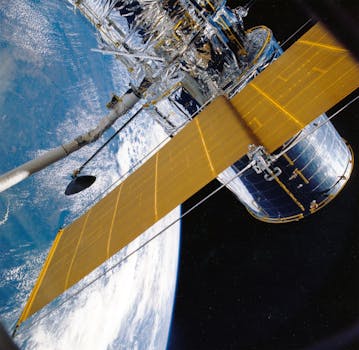
GEO Satellites: Understanding the Technology and Impact
GEO satellites, or Geostationary Earth Orbit satellites, are a type of satellite that orbits the Earth at an altitude of approximately 36,000 kilometers, remaining stationary relative to a fixed point on the Earth’s surface. This unique characteristic allows GEO satellites to provide continuous coverage of a specific region, making them ideal for a variety of applications, including telecommunications, weather forecasting, and navigation.
The technology behind GEO satellites is complex and involves a range of sophisticated systems and components. The satellite itself is typically equipped with a range of instruments, including transponders, antennas, and solar panels, which enable it to receive and transmit signals, as well as generate power. The satellite is launched into space using a powerful rocket and is then maneuvered into its geostationary orbit, where it remains for the duration of its operational life, typically between 10 to 15 years.
Applications of GEO Satellites
GEO satellites have a wide range of applications, including telecommunications, where they are used to provide internet connectivity, television broadcasting, and mobile phone networks. They are also used for weather forecasting, where they provide high-resolution images of cloud patterns, sea surface temperatures, and other meteorological data. Additionally, GEO satellites are used for navigation, providing location information and timing signals for GPS and other satellite navigation systems.
In recent years, the use of GEO satellites has expanded to include a range of new applications, such as Earth observation, where they are used to monitor climate change, track natural disasters, and provide insights into the health of our planet. They are also used for space exploration, providing communications relay services for deep space missions and enabling the transmission of scientific data from spacecraft.
Benefits and Challenges of GEO Satellites
The use of GEO satellites offers a range of benefits, including global coverage, high-bandwidth connectivity, and reliable communications. They also provide a cost-effective solution for telecommunications and other applications, as they can reach a large audience with a single satellite. However, there are also challenges associated with the use of GEO satellites, including the risk of satellite failure, interference from other satellites, and the need for frequent replacement and maintenance.
Furthermore, the increasing number of satellites in geostationary orbit has raised concerns about space debris and the potential for collisions. As a result, there is a growing need for sustainable and responsible practices in the use of GEO satellites, including the development of more efficient and environmentally friendly technologies.
Future Developments and Trends
The future of GEO satellites is likely to be shaped by a range of technological advancements and trends, including the development of newer and more efficient satellite technologies, such as high-throughput satellites and quantum satellites. There will also be an increasing focus on sustainability and environmental responsibility, with the development of more efficient and environmentally friendly satellite systems.
In addition, the growth of the satellite industry is expected to continue, with an increasing number of countries and companies launching their own satellites and developing new applications and services. As a result, there will be a growing need for international cooperation and regulation, to ensure the safe and sustainable use of GEO satellites and to prevent the risk of conflicts and collisions.



